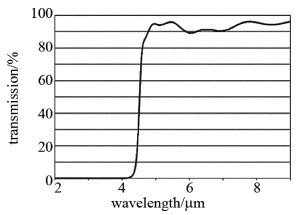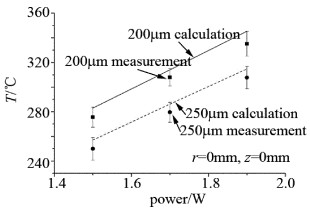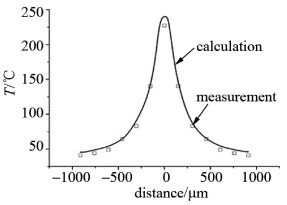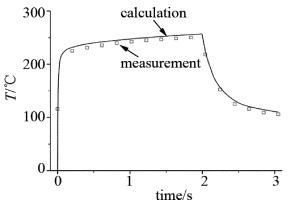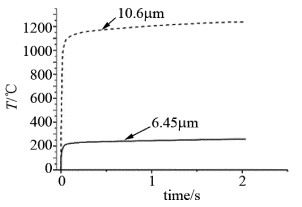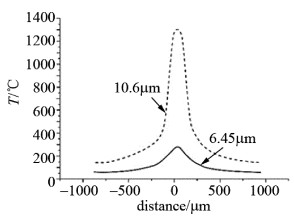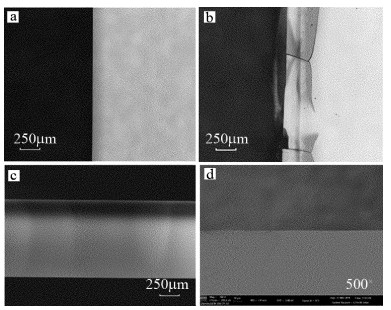Research of temperature distribution in float glass after heating by 6.45μm laser
-
摘要: 为了提升激光可控断裂法切割玻璃的质量,研究了6.45μm激光照射浮法玻璃后材料的温度变化。利用激光输出的连续功率计算了6.45μm激光照射玻璃后的温度分布,并通过实验验证了该模型的正确性;模拟对比了相同激光参量下6.45μm激光和10.6μm激光加热玻璃后的温度场,通过实验获得了光滑、无表面裂纹的切割样品。结果表明,6.45μm激光产生的表面温度低于10.6μm激光;6.45μm激光可以利用热裂法获得高质量切割端面。该研究对中红外激光玻璃切割的模型建立和方案优化具有一定的帮助。Abstract: In order to improve the quality of glass cut by laser controlled fracture method, the temperature change of material after 6.45μm laser irradiation was studied. The temperature distribution of glass irradiated by 6.45μm laser was calculated by using the continuous laser output power, and the correctness of the model was verified by experiments. Temperature field of glass heated by 6.45μm laser and 10.6μm laser under the same laser parameters was simulated and compared. The smooth and crack-free cutting samples were obtained by experiment. The results show that, the surface temperature of 6.45μm laser is below than that of 10.6μm laser. 6.45μm laser can obtain high quality cutting face by hot cracking. The research is helpful for the modeling and the optimization of mid infrared laser glass cutting.
-
Keywords:
- laser technique /
- laser cutting /
- crack controlled method /
- 6.45μm laser /
- float glass
-
-
Table 1 Physical properties of float glass at different temperatures[18]
temperatureT/ ℃ density ρ/
(kg·m-3)thermal conductivity κ/
(W·m-1·K-1)specific heat capacity c/
(J·kg-1·K-1)25 2.43×103 1.06 8.28×102 200 — 1.23 1.01×103 400 — 1.38 1.16×103 500 — -
[1] LUO Y Q. Research and design of annealing kiln of float glass[D]. Chengdu: Chengdu University of Technology, 2009: 1-2(in Chinese).
[2] UNGER U, WITTENBECHER W. The cutting edge of laser technology[J]. Glass, 1998, 75:101-103. http://d.old.wanfangdata.com.cn/OAPaper/oai_pubmedcentral.nih.gov_2922833
[3] NISAR S, LI L, SHEIKH M A. Laser glass cutting techniques-A review[J]. Journal of Laser Applications, 2013, 25(4):042010-042011. DOI: 10.2351/1.4807895
[4] LUMLEY R M. Controlled separation of brittle materials using a laser[J].American Ceramic Society Bulletion, 1969, 48(1):850-854. http://www.wanfangdata.com.cn/details/detail.do?_type=perio&id=fae59c57d128ef3a234a6b89bc4ab3b4
[5] TSAI C H, LIOU C S. Fracture mechanism of laser cutting with controlled fracture[J]. Journal of Manufacturing Science and Engineering, 2003, 125(8):519-528. DOI: 10.1115-1.1559163/
[6] TONSHOFF H K, OSTENDORF A, KULIK C, et al. Final glass products in one processing step by the means of laser radiation[C]//In Proceedings of the 22nd International Congress on Applications of Lasers and Electro-Optics. Jacksonville, USA: Laser Institute America, 2003: 71-80.
[7] NISAR S, SHEIKH M A, LI L, et al. Effect of thermal stresses on chip-free diode laser cutting of glass[J]. Optics & Laser Technology, 2009, 41(3):318-327. http://cn.bing.com/academic/profile?id=951e04206e3e01e9d75bcc54427a21da&encoded=0&v=paper_preview&mkt=zh-cn
[8] NURSE D, PATERSON N, TAWN A, et al. On the numerical modeling of laser shearing of glass sheets used to optimize production methods[J]. Journal of Mechanical Engineering Science, 2004, 218(1):218-229. http://cn.bing.com/academic/profile?id=35d6782fde9e95f7bc703eaad87a68ce&encoded=0&v=paper_preview&mkt=zh-cn
[9] WANG X H, YAO J H, ZHOU G B, et al. Research of the technology of laser cutting LCD glass substrates based on thermal cracking method[J]. Laser Technology, 2011, 35(4):472-476(in Chinese). http://www.wanfangdata.com.cn/details/detail.do?_type=perio&id=jgjs201104009
[10] WANG Ch G, ZHOU G B, LU Y L, et al. Research of cutting LCD-glass with thermal cracking method based on thermal weight function technology[J]. Chinese Journal of Lasers, 2014, 12(41):1203005(in Chinese). http://www.wanfangdata.com.cn/details/detail.do?_type=perio&id=zgjg201412016
[11] AKARAPU R, SEGALL A E. Investigation of an active stressing technique for delaying fracture during laser cutting of alumina[C]//International Mechanical Engineering Congress and Exposition. Anaheim California, USA: American Society of Mechanical Engineers, 2004, 15: 173-179.
[12] YAHATA K, YAMAMOTO K. Crack propagation analysis in laser scribing of glass[J]. Journal of Laser Micro/Nano Engineering, 2010, 5(2):109-114. DOI: 10.2961/jlmn.2010.02.0002
[13] LIN H Y, HUANG X H, XU Y Ch, et al. Research progress of graphene passively Q-switched Nd3+-doped lasers[J]. Laser Technology, 2016, 40(2):259-263(in Chinese).
[14] XIA J, JIANG G B, ZHAO Ch J. Numerical study on thulium-doped mode-lock fiber laser with high modulation depth of saturable aborsber[J].Laser Technology, 2016, 40(2):259-263(in Chinese).
[15] LIU H, FENG L Q. Mid-infrared field phase measurement and attosecond pulse generation[J].Laser Technology, 2017, 41(2):151-158(in Chinese). http://d.old.wanfangdata.com.cn/Periodical/jgjs201702001
[16] SOLDATOV A N, MIRZA Y S, POLUNIN Y P. Thermal cleavage of optical glass by strontium-vapor laser radiation[J]. Glass and Ceramics, 2015, 71(12):379-382. http://www.wanfangdata.com.cn/details/detail.do?_type=perio&id=6cede5ddb9c81ed5d4f07d4527310699
[17] KITAMURA R, PILON L, JONASZ M. Optical constants of silica glass from extreme ultraviolet to far infrared at near room temperature[J]. Applied Optics, 2007, 46(33):8118-8133. DOI: 10.1364/AO.46.008118
[18] AWAJIHI D, HONDA S, NISHIKAWA T. Thermal shock parameters of ceramics evaluated by infrared radiation heating[C]//JSME International Journal Series A (Solid Mechanics and Material Engineering). Tokyo, Japan: Japan Society of Mechanical Engineerings, 1997: 414-436.
[19] YANGS T, MATTHEWS M J, ELHADJ S. Thermal transport in CO2 laser irradiated fused silica in situ measurements and analysis[J]. Journal of Applied Physics, 2009, 106(10):1031061-1031067. http://www.wanfangdata.com.cn/details/detail.do?_type=perio&id=5ec5a9bf6350ef0a43d9006cfdb6de22
[20] YANG S T, MATTHEWS M J, ELHADJ S, et al. Comparing the use of mid-infrared versus far-infrared lasers for mitigating damage growth on fused silica[J]. Journal of Applied Optics, 2010, 49(14):2606-2616. DOI: 10.1364/AO.49.002606



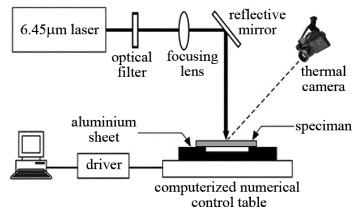
 下载:
下载:
